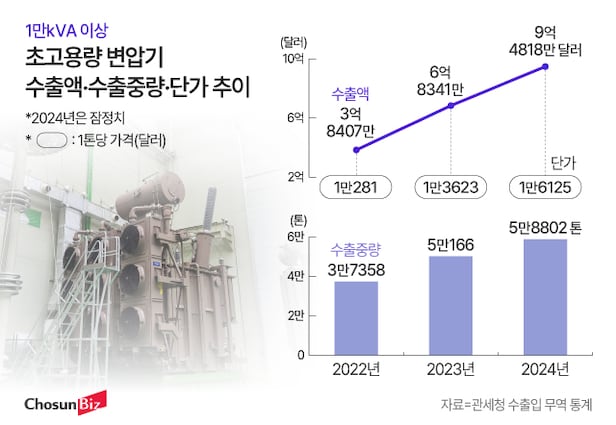Last year, South Korea's transformer export performance showed a significant increase compared to the past. The export amount, export weight, and unit price all rose. This is interpreted as the result of increased demand for expansion of power grids in recent years, leading to more foreign countries, including the United States, seeking South Korean transformers.
According to the Korea Customs Service export-import trade statistics on the 3rd, the export amount and weight of ultra-high-capacity transformers of 10,000 kilovolt-amperes (㎸A) or more from January to December last year were provisionally recorded at $948.18 million (approximately 1.4 trillion won) and 58,802 tons (t), respectively. This represents increases of 38.7% in export value and 17.2% in export weight compared to 2023. Compared to 2022 statistics, export value and weight increased by 146.9% and 57.4%, respectively.

For ultra-high-capacity transformers, the growth in export value has outpaced that of export weight, indicating that product prices have risen compared to the past. In fact, the export amount per ton of transformer weight has increased as follows: ▲ $10,201 in 2022 ▲ $13,623 in 2023 ▲ $16,125 in 2024.
Transformers are devices that change voltage. Electricity moves with higher energy when the voltage is higher. However, the electricity generated at power plants does not have sufficient voltage to reach far distances. To send it over long distances, thick wires must be used, or transformers are employed to artificially boost the voltage, making the latter more cost-effective.
Typically, the lifespan of transformers is 20 to 30 years. However, according to a 2020 survey by the U.S. Department of Energy, about 70% of large transformers in the United States have exceeded their installation lifespan of 25 years. Moreover, with the Inflation Reduction Act (IRA) leading to the construction of numerous factories across the United States and the increase in data center construction amid the era of artificial intelligence (AI), demand for transformers is rising.
The performance of domestic companies that produce and export transformers is also on the rise. According to financial data firm FnGuide, HD Hyundai Electric is estimated to have recorded sales of 3.5155 trillion won and operating profit of 712.3 billion won last year. This reflects increases of 30% in sales and 130% in operating profit compared to the previous year. Hyosung Heavy Industries and LS Electric also reported that their cumulative performance up to the third quarter last year was close to the total performance for 2023.
The workload has also significantly increased. As of the third quarter of last year, HD Hyundai Electric secured a backlog of orders worth 7.2 trillion won, Hyosung Heavy Industries (institutional sector) 7.3 trillion won, and LS Electric (power sector) 2.9 trillion won. This marks an increase of nearly double over the past two years. Companies are already in a situation where they have secured about five years' worth of workloads and only take contracts for new orders that are highly profitable.
Predictions indicate that the transformer market in the incoming Trump administration in the United States will continue to be favorable. Jo Yeon-joo, a researcher at Mirae Asset Securities, noted, "Last October, the United States announced a government-led investment plan for the transmission and distribution network worth $3.5 billion (approximately 5.13 trillion won), which is expected to continue into the second term of the Trump administration," adding, "In a situation where the United States is facing a shortage of power supply, it is difficult to impose high levels of tariffs on South Korean transformers."